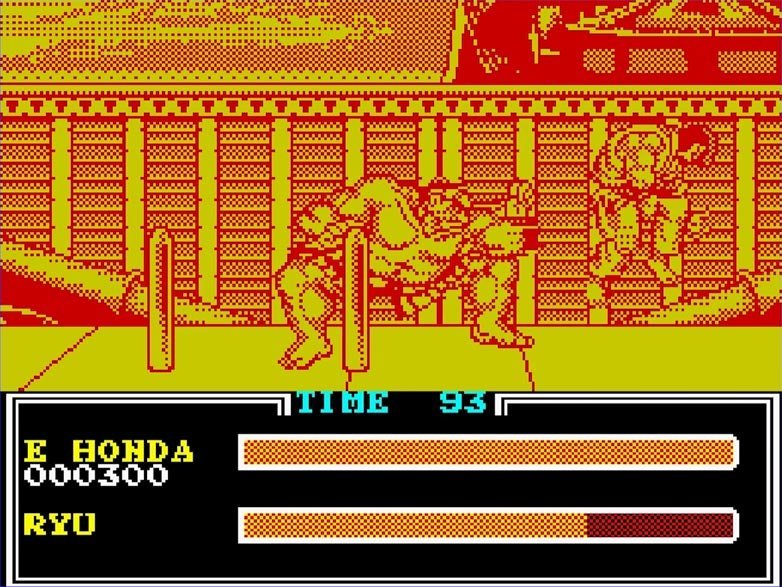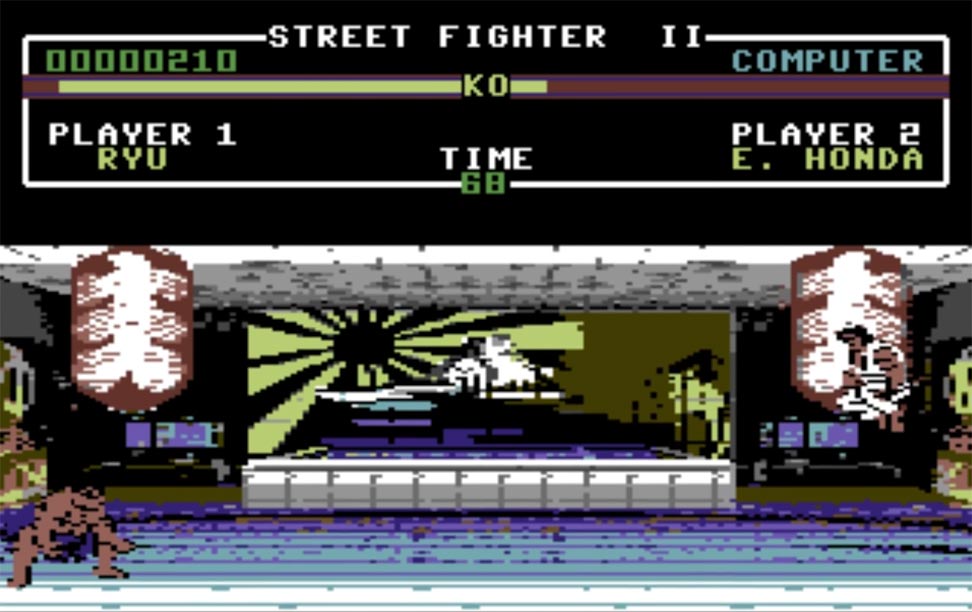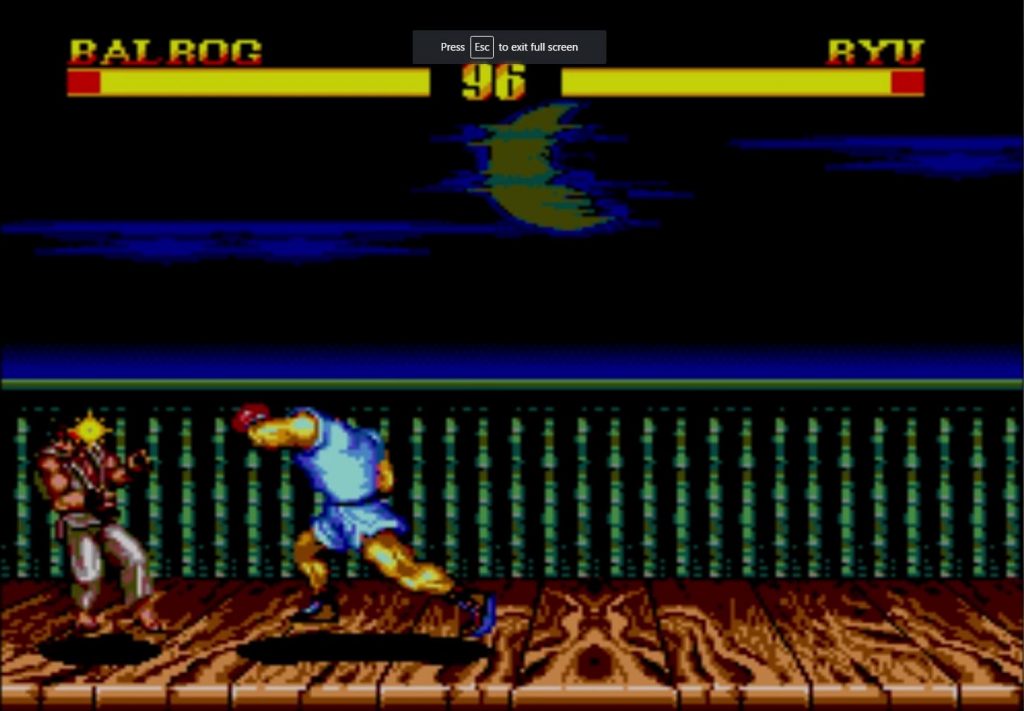This is the first in a series which looks at where you would simply ‘make do’ with 8-bit conversions. Maybe because like me, you were too young to afford the likes of the Sega Mega Drive or Super Nintendo. It was not just the systems that were expensive, game prices meant 16-bit glory was often out of reach.
Let’s kick things off with a look at Street Fighter 2, a masterpiece which has stood the test of time. The game is still hugely popular and has received numerous re-releases across virtually every platform going.
Street Fighter 2, the World Warrior. It is a one-on-one competitive fighter which took the arcades by storm back in 1991. It has 8 playable characters to choose from, each with its own story, fighting style and special moves. This means there is very much of a strategy when you are up against each character.
My first experience with street fighter 2 was in the summer of 1992. A small independent game store had bought a World Warrior arcade machine. I conveniently passed this every day to and from school, which proved to be quite expensive!
Soon enough, it was announced that street fighter 2 was being released on the SNES. This created a huge buzz among gamers, many of those who did not have a SNES buying one especially.
The SNES version launched across Europe in December 1992. With a release price of around £60-£70, this was out of reach for your average gamer back then. Many still owned 8-bit machines and were accustomed to paying £9.99 for a bigger title and often £1.99 for budget games.
Here Comes a New Challenger
We’ll be covering 4 versions of the game on 8-bit systems. The Commodore 64, ZX Spectrum, Game Boy and Master System versions. Although the latter two versions appeared much later than the original SNES version. The Brazilian Master System conversion was launched in 1997. (Since the Master System was still hugely popular in Brazil), is worth a look if anything from a technical standpoint.
All of these conversions clearly have been downgraded from the arcade version, even the SNES game makes compromises. Things such as bonus levels, certain characters, backgrounds, character animation frames, and the list go on. I won’t be dwelling on all of these points, just taking a broad look at each. Besides, back then you were quite used to having to compromise with 8-bit games, so street fighter 2 was always going to be tight in its offering.
People’s expectations should really have been modest, even at the time. Perhaps it would have been my naivety as an 11-year-old, but I had high hopes for the Spectrum version.
Let’s take a look at how things went down!
ZX Spectrum
Let’s be realistic, we were never going to see a full-colour conversion with huge sprites running at 60fps. Screenshots released in reviews for Street Fighter 2 on the ZX Spectrum created a real buzz for the upcoming launch
Impressive sprites aside and a small amount of music, the Spectrum game in motion is when reality struck. Once you get past the fairly well-drawn graphics It is the terrible FPS, inconsistent collision detection and responsiveness of the controls which make the game virtually unplayable.
Unbelievably these issues are the least of the game’s worries. In addition to the initial load time, the game is a multi-load. This is where each section has to load before you can play the next. For example, you had to load level backgrounds from side 2 of the tape and let it run until it found the right section of the tape. This can take any amount of time up to the whole length of the tape as you have no idea where the correct part of the tape is!

When you finally get into the game and finish the fight, you rewind to the beginning of side 1 to load the character select screen. This repeats until ultimately, you get sick of this process and turned off the game!
Ultimately the game was a resounding disappointment, like with many 8-bit games, your imagination fills the blanks. (Whilst seething with jealousy at those who were playing their more or less arcade-perfect SNES games!).
1.5 out of 5 rating
Commodore 64
The Commodore 64 version was a very different approach to the Spectrum effort. This is mainly down to technical differences between machines in terms of what was possible with the resolution, sound and colours available.
Unfortunately the game does not quite make as good a first impression as the Spectrum version. The characters are almost unrecognisable aside from their colours, there’s too much detail being attempted here which results in the character sprites clashing with the backgrounds.
Music is sparse, but at least you get music throughout the game. Albeit the same song constantly played!
Once again, load times and the multi-load system is what ruin the Street Fighter 2 experience on the Commodore 64. It interrupts the flow of the game far too much for it even to be enjoyable to any extent and this is not even just in retrospect. Even at the time of release, game reviews panned for its loading system.

In terms of playing the game, the Commodore 64 delivers a welcome smoother experience. Frame rates are much improved over the Spectrum, at the cost of resolution and the size of the sprites. But, on the positive side, I would consider the game semi-playable as a result.
The control system and collision detection are what ultimately ruins any real enjoyment of when you’re actually in the game though, but at least you can move left to right reasonably easily in this version!
Worth a play on an emulator just so you can attempt the game at least!
2 out of 5, slightly pips the Spectrum version in my mind as you can at least semi-control characters with the better frame rates
Game Boy
The Game Boy of course is an 8-bit handheld console, not quite the same era as the C64 and Spectrum. In terms of converting a decent enough version of Street Fighter 2, faced many similar challenges as the home computer versions did.
Released in 1995, Straight off the bat though, the Game Boy version has so many things going for it. Yes, it obviously has monochrome graphics, but it pulls off everything else which the home computer versions did not.
Some things are unfair by comparison, such as the Game Boy load times will obviously benefit as it’s on a cartridge. It also has a d-pad and two fire buttons, but the game is just a lesson in how you can take a game too advanced for a system and convert it down to something still as enjoyable.

The game is quite jerky due to the limited number of frames in the character animations. Most crucially, the collision detection and the controls feel much more like an authentic Street Fighter 2 experience.
It’s worth noting that the Game Boy version is based on Super Street Fighter 2. Unfortunately, E Honda, Dhalsim and Vega were missing from the game, but the remaining 9 were playable characters.
Give the Game Boy version a try after you have played the Spectrum & C64 versions, you will instantly be relieved at the much much better playability of the game.
All in all, a hugely satisfying Street Fighter 2 experience. Considering it is on a portable device, not a lot of bad can be said about this conversion.
4 out 5
Master System
The 1997 Master System version of Street Fighter 2 was launched only in Brazil by Tec Toy,
Let’s start with the positives. It looks amazing for a Master System game. The palette is applied well given the limitations and the sprites are a very good size. I’ve read opinions that criticise the game for being dumbed down from the Mega Drive version. Let’s not get too excited though, it looks amazing for a Master System game!
Each level has the correct music which has that classic master system PSG chip sound. In-game, sounds are really limited, but at least there is something to represent a punch or kick noise. BUT it does have some speech, at least when you select your character, when the rounds start and when you win or lose, still a nice touch on a system where speech was rare and actually is a little clearer than in the Mega Drive version.

Unfortunately where a lot of love have been given to the graphics, they appear to have run out of steam with the gameplay. Possibly limitations with the hardware, or maybe shoddy just work. Either way, it’s got that same kind of feeling as the Spectrum & C64 version has, where collision detection feels all over the place and the controls almost seem to have a mind of their own.
The game is quite buggy, often you’ll find characters stop mid-air a float for a little while and also the frame rates and animation do not help things either, this makes controlling the game not quite as hard as the Spectrum & C64, but certainly behind the Game Boy version.
Not a bad effort at a time when the Master System was two generations old in 1997.
2.5 out of 5
VERDICT
I certainly consider the Game Boy version the clear winner of the 8-Bit versions of Street Fighter 2.
The other 8-bit platforms faced an uphill struggle before work had even commenced. It is a game that requires concise controls, speed and accuracy, something the Game Boy managed to achieve. It did not have to rely on pretty graphics, the feel of the game pulled it off alone.
In terms of the worst version, it’s definitely between the Spectrum & C64. I have always been a Speccy kid and that’s where loyalty would typically lie.
However, I admit that the C64 version did beat it as I was able to maintain control of the characters SLIGHTLY more so over the Spectrum version. But ultimately both were garbage because of the obscene multi-loader.
See what you had to put up with as an 8-bit gamer. What mattered most is that you had Street Fighter 2 on YOUR machine, which meant everything!
BE SURE TO CHECK OUT AND SUBSCRIBE TO THE ‘HOW TO RETRO’ YOU TUBE CHANNEL.

A lifelong avid gamer and computing enthusiast, Matt has decades of Retro Gaming experience. Now over 40 years old, Matt now even considers himself retro, but fortunately, nobody has developed a Matt emulator (not yet at least!).